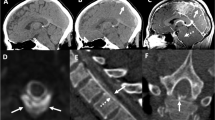Abstract
Diffuse pachymeningeal enhancement on magnetic resonance (MR) imaging is important in identifying spontaneous and secondary intracranial hypotension (IH) [cerebrospinal fluid (CSF) hypovolemia] in patients with postural headache, because CSF pressure at lumbar puncture is variable. We examined the pachymeningeal enhancement pattern in patients with IH. MR imaging findings of pachymeningeal enhancement were examined before and after treatment in seven consecutive patients with spontaneous IH and one patient with IH after lumbar puncture. Diffuse non-nodular dural enhancement was observed in all patients. Characteristic thick, uninterrupted, enhancement was observed, mainly in the dura of the frontal, temporal, and retroclival regions, and the tentorium. Thin and uninterrupted, or partially interrupted, enhancement was observed, mainly in the parieto-occipital region and cerebellar convexity. Curved linear enhancement was observed along the calvarium of all patients. A wave-like appearance, a clear pattern of dural unevenness parallel to the brain, was detected in the frontal and temporal regions, near the base, in all patients. A wave-like appearance, especially in the frontal and temporal base, may be a characteristic MR imaging indicator of IH.


Similar content being viewed by others
References
Mokri B, Kruger BR, Miller GM, Piepras DG (1991) Meningeal gadolinium enhancement in low pressure headaches (abstract). Ann Neurol 30:294–295
Hochman MS, Naidich TP, Kobetz SA, Fernandez-Maitin A (1992) Spontaneous intracranial hypotension with pachymeningeal enhancement on MRI. Neurology 42:1628–1630
Mokri B, Piepgras DG, Miller GM (1997) Syndrome of orthostatic headaches and diffuse pachymeningeal gadolinium enhancement. Mayo Clin Proc 72:400–413
Mokri B (2001) The Monro–Kellie hypothesis: applications in CSF volume depletion. Neurology 56:1746–1748
Blank SC, Shakir RA, Bindoff LA, Bradey N (1997) Spontaneous intracranial hypotension: clinical and magnetic resonance imaging characteristics. Clin Neurol Neurosurg 99:199–204
Tsui EY, Ng SH, Cheung YK, Fong D, Yuen MK (2001) Spontaneous intracranial hypotension with diffuse dural enhancement of the spinal canal and transient enlargement of the pituitary gland. Eur J Radiol 38:59–63
Ly JN, DeSilva SJ, Brazier D (1999) Spontaneous intracranial hypotension. Australas Radiol 43:548–550
Ferrante E, Guccione A, Brioschi AM, Gerini AM, Reverdito C, Riva M (1995) Primary intracranial hypotension: pathogenetic and neuroradiological considerations. Ital J Neurol Sci 16:527–532
Fukui MB, Meltzer CC, Kanal E, Smirniotopoulos JG (1996) MR imaging of the meninges. Part II. Neoplastic disease. Radiology 201:605–612
Tosaka M, Tamura M, Oriuchi N, Horikoshi M, Joshita T, Sugawara K, Kobayashi S, Kohga H, Yoshida T, Sasaki T (2001) Cerebrospinal fluid immunocytochemical analysis and neuroimaging in the diagnosis of primary leptomeningeal melanoma. Case report. J Neurosurg 94:528–532
Li JY, Lai PH, Lam HC, Lu LY, Cheng HH, Lee JK, Lo YK (1999) Hypertrophic cranial pachymeningitis and lymphocytic hypophysitis in Sjogren’s syndrome. Neurology 52:420–423
Kawano Y, Kira J (1995) Chronic hypertrophic cranial pachymeningitis associated with HTLV-I infection. J Neurol Neurosurg Psychiatry 59:435–437
Fujimaki H, Saito N, Tosaka M, Tanaka Y, Horiguchi K, Sasaki T (2002) Cerebrospinal fluid leak demonstrated by three-dimensional computed tomographic myelography in patients with spontaneous intracranial hypotension. Surg Neurol 58:280–285
River Y, Schwartz A, Gomori JM, Soffer D, Siegal T (1996) Clinical significance of diffuse dural enhancement detected by magnetic resonance imaging. J Neurosurg 85:777–783
Haines DE, Harkey HL, al-Mefty O (1993) The “subdural” space: a new look at an outdated concept. Neurosurgery 32:111–120
Mokri B, Parisi JE, Scheithauer BW, Piepgras DG, Miller GM (1995) Meningeal biopsy in intracranial hypotension: meningeal enhancement on MRI. Neurology 45:1801–1807
Tuite GF, Evanson J, Chong WK, Thompson DN, Harkness WF, Jones BM, Hayward RD (1996) The beaten copper cranium: a correlation between intracranial pressure, cranial radiographs, and computed tomographic scans in children with craniosynostosis. Neurosurgery 39:691–699
Schreiber F (1930) Intracranial pressure: the correlation of choked disc and roentgenologic pressure signs. AJR Am J Roentgenol 33:607–611
Bruera OC, Bonamico L, Giglio JA, Sinay V, Leston JA, Figuerola ML (2000) Intracranial hypotension: the nonspecific nature of MRI findings. Headache 40:848–852
Apte RS, Bartek W, Mello A, Haq A (1999) Spontaneous intracranial hypotension. Am J Ophthalmol 127:482–485
Matsumura A, Anno I, Kimura H, Ishikawa E, Nose T (2000) Diagnosis of spontaneous intracranial hypotension by using magnetic resonance myelography. Case report. J Neurosurg 92:873–876
Moayeri NN, Henson JW, Schaefer PW, Zervas NT (1998) Spinal dural enhancement on magnetic resonance imaging associated with spontaneous intracranial hypotension. Report of three cases and review of the literature. J Neurosurg 88:912–918
Nokes SR, Dickins RD, Pierce WB (1996) Radiological case of the month. Spontaneous intracranial hypotension. J Ark Med Soc 92:595–596
O’Carroll CP, Brant-Zawadzki M (1999) The syndrome of spontaneous intracranial hypotension. Cephalalgia 19:80–87
Schievink WI, Smith KA (1998) Nonpositional headache caused by spontaneous intracranial hypotension. Neurology 51:1768–1769
Bang OY, Kim DI, Yoon SR, Choi IS (1998) Idiopathic hypertrophic pachymeningeal lesions: correlation between clinical patterns and neuroimaging characteristics. Eur Neurol 39:49–56
Wild T, Strotzer M, Volk M, Feuerbach S (1999) Idiopathic hypertrophic cranial pachymeningitis associated with an orbital pseudotumor. Eur Radiol 9:1401–1403
Choi IS, Park SC, Jung YK, Lee SS (2000) Combined therapy of corticosteroid and azathioprine in hypertrophic cranial pachymeningitis. Eur Neurol 44:193–198
Acknowledgments
We thank Drs. Fumiaki Honda, Keishi Horiguchi, Yukitaka Tanaka, and Kaiei Kagoshima of Gunma University for helpful advice.
Author information
Authors and Affiliations
Corresponding author
Rights and permissions
About this article
Cite this article
Tosaka, M., Sato, N., Fujimaki, H. et al. Wave-like appearance of diffuse pachymeningeal enhancement associated with intracranial hypotension. Neuroradiology 47, 362–367 (2005). https://doi.org/10.1007/s00234-005-1366-8
Received:
Accepted:
Published:
Issue Date:
DOI: https://doi.org/10.1007/s00234-005-1366-8




